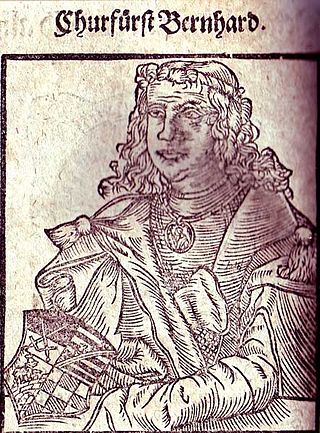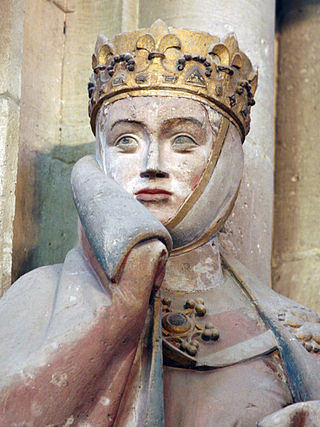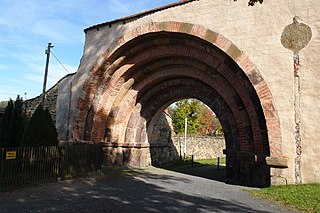
Gernrode is a historic town and former municipality in the Harz District, in Saxony-Anhalt, Germany. Since 1 January 2014, it has been part of Quedlinburg. It was the seat of the former Verwaltungsgemeinschaft of Gernrode/Harz.

Ballenstedt is a town in the Harz district, in the German state of Saxony-Anhalt.

Eckard II was Margrave of Lusatia from 1034 and Margrave of Meissen from 1038 until his death. He was the last of his dynasty, with his death the line of Ekkeharding margraves descending from Eckard I of Meissen became extinct.
Conrad I, called the Great, a member of the House of Wettin, was Margrave of Meissen from 1123 and Margrave of Lusatia from 1136 until his retirement in 1156. Initially a Saxon count, he became the ruler over large Imperial estates in the Eastern March and progenitor of the Saxon electors and kings.

Bernhard, a member of the House of Ascania, was Count of Anhalt and Ballenstedt, and Lord of Bernburg through his paternal inheritance. From 1180 he was also Duke of Saxony.

Adelaide I, a member of the royal Ottonian dynasty was the second Princess-abbess of Quedlinburg from 999, and Abbess of Gernrode from 1014, and Abbess of Gandersheim from 1039 until her death, as well as a highly influential kingmaker of medieval Germany.

Anhalt Castle is a ruined medieval fortification near the town of Harzgerode in Saxony-Anhalt, Germany.
Esico of Ballenstedt is the progenitor of the House of Ascania,. Esico was the count of Ballenstedt, and his possessions became the nucleus of the later Principality of Anhalt.

Hedwig of Brandenburg, also called Hedwig of Ballenstedt, a member of the House of Ascania, was Margravine of Meissen from 1156 until 1190 by her marriage with Margrave Otto II.

Uta von Ballenstedt, a member of the House of Ascania, was Margravine of Meissen from 1038 until 1046, the wife of Margrave Eckard II. She is also called Uta of Naumburg as the subject of a famous donor portrait by the Naumburg Master.

Altzella Abbey, also Altzelle Abbey, is a former Cistercian monastery near Nossen in Saxony, Germany. The former abbey contains the tombs of the Wettin margraves of Meissen from 1190 to 1381.

John II, Margrave of Brandenburg-Stendal was co-ruler of Brandenburg with his brother Otto "with the arrow" from 1266 until his death. He also used the title Lord of Krossen, after a town in the Neumark.
Sophie of Winzenburg was the first Margravine of Brandenburg.

Saint Cyriakus is a medieval church in Gernrode, Saxony-Anhalt, Germany. It is one of the few surviving examples of Ottonian architecture, built in 959/960–965 by Margrave Gero, although it was restored in the 19th century. From its foundation until 1614, Saint Cyriakus was the collegiate church of the Abbey of Gernrode, also founded by Margrave Gero. The church and the abbey became Protestant in the mid-sixteenth century, and the church is now used by the Protestant community of Gernrode.

Otto III. Weimar-Orlamünde, sometimes called Otto IV was a German nobleman. He was a member of the House of Ascania and a titular Count of Weimar-Orlamünde. He was the ruling Count of Weimar and Lord of Rudolstadt and Plassenburg.

Buch Abbey, in German Kloster Buch, is a former Cistercian monastery near Leisnig in Saxony.

Sophia of Saxony was a member of the House of Ascania, and the abbess of Gernrode (r.1220–1244).
Adalbert von Ballenstedtc. 970,, was Count of Ballenstedt, Vogt of the Nienburg Abbey, and the provost of Hagenrode. He is the earliest known ancestor of the House of Ascania.















